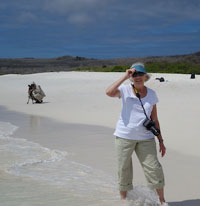
Isabela, Floreana, Bartolome, San Cristobal, Santa Cruz, Sombrero Chino, Genovesa… The Enchanted Islands.
The Galapagos Archipelago.
Across the Equator, past the 90th parallel, lies what we think of as the Land of Darwin, although it isn’t really. He spent only five weeks here in 1835, visited only four islands, then waited 24 years to officially publish his formulation of natural selection, an idea which changed the way the scientific world thought.
What a wonderful place to visit, to see what Darwin saw. But when it came right down to it (call us shallow), we just wanted to see giant tortoises and the blue-footed booby.
We started our adventure almost a year ahead of time, planning a family trip with our son Matt, his wife Mary, and their children Emily and Jack. We figured everyone was old enough to remember this expedition (but not too old to forget it) and found that National Geographic/Lindblad offered family-centered trips aboard the expedition ship Endeavor. We booked the last three available cabins.
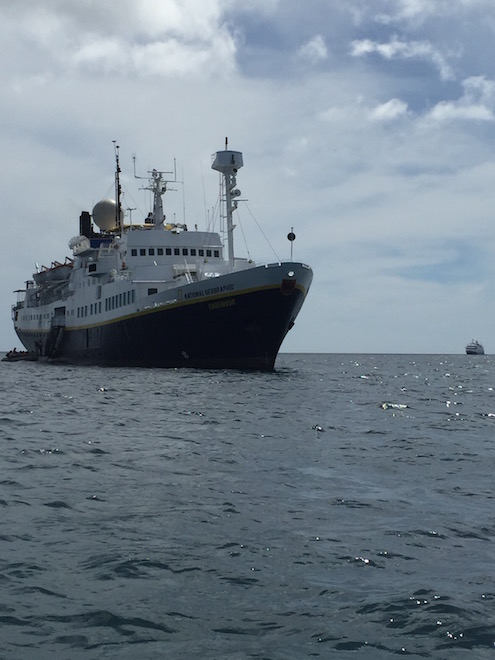
Dallas to Miami to Guayacil, Ecuador, should have been three straight forward flights except for the summer storm which gave us an extra four hours in the Miami Airport, a 2 AM arrival in Ecuador, and a 5 AM wake-up call at the hotel for our 7 AM flight to the island of San Cristobal, the Galapagos. So we started tired and it wasn’t just the six of us. Fifty-seven of the ninety-six passengers headed to the Endeavor were on that flight. But we took our sleepy attitudes in hand, were welcomed to the island, put on a bus, let out at the wharf to explore, and informed the Zodiacs (rubber boats holding 12-14 passengers) would be leaving for the ship in about thirty minutes.
And here we must pause to mention just how closely tied the populations of people and animals are, along with the words of wisdom from a National Park Ranger in The Tetons many years ago: “Don’t take a photo of the first buffalo (sea lion, blue-footed booby) you see. There are more.”
The more in this case started at the wharf with sea lions (there are no seals here) cavorting and totally oblivious to the tourists gawking at them. The people of the island paid them no mind. Me? I have photos.
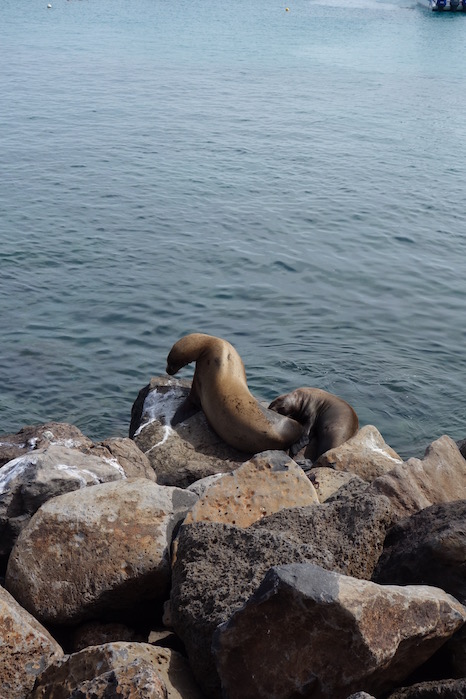
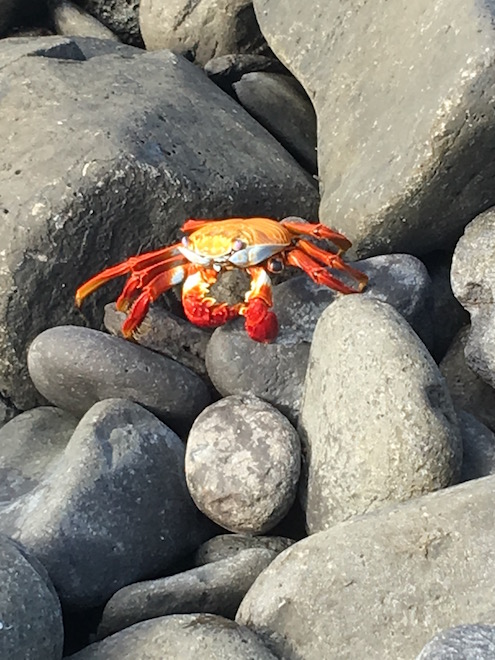
Donning life jackets at the wharf, we were whisked by Zodiacs to the Endeavor at anchor in Wreck Bay. We settled into our three adjacent cabins, had the obligatory safety drill, lunch and an orientation before heading back into town to an interpretation center and a lovely walk up (UP!) to the overview at Frigate Bird Hill. Along the way we were introduced to one of the four subspecies of Galapagos mockingbird and the palo santo or incense trees, currently leafless as it wasn’t the rainy season, therefore looking very dead. We were assured they were not.
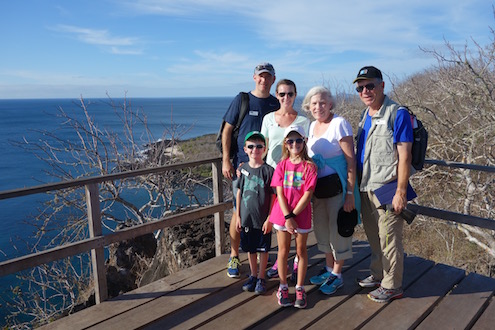
We quickly settled into life aboard ship. All transit to and from the ship was done by Zodiac so life jackets were kept in our cabins and donned several times a day. When landing, we left them in the center of the Zodiac, retrieving when we were returning to the ship. There was a magnetic board by the disembarkation door, where we moved our cabin pieces back and forth to say aboard or not.
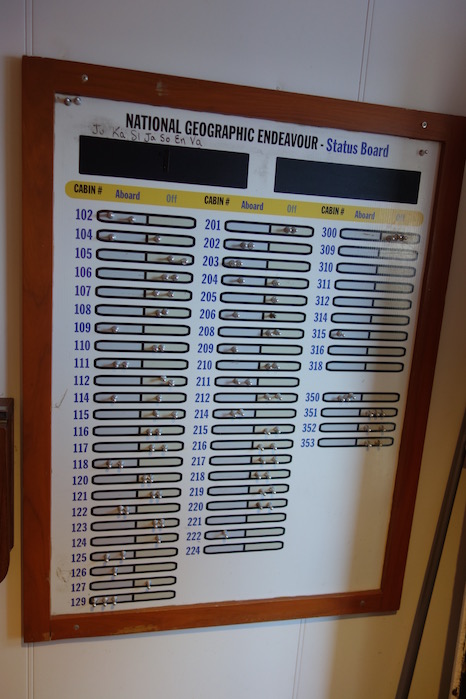
Informational programs were held in the lounge where there was an honor beer fridge and coffee and soda machines. Talk about spoiled! On the last day I heard one young teen tell a friend she was “so over mocachinnoes.” TV screens monitored our progress about the islands and announced the day’s upcoming activities.
There were 72 staff to 96 passengers. Our beds were made by the time we returned from breakfast; towels were a la hotel rules: not replaced unless on the floor. A laundry service was available. Breakfast and lunch were buffet style and dinner was served. The atmosphere was relaxed, casual. I can’t think of the last time I went with so little makeup for a week.
Day 2 found us docked at Espanola Island with our adventure about to begin in earnest. After breakfast it was time to get fitted with snorkeling gear. I’m not a snorkeler but I watched the controlled chaos as everyone was fitted with wet suits and fins. Next stop: deep water snorkeling for those experienced enough to not need to touch bottom and beach snorkeling for those needing a few get-acquainted lessons. My troop headed to the beach at Gardner Bay and I went with them.
Sea lions, marine iguanas, and Espanola mockingbirds looking for water abounded. None were afraid of us, that’s for sure.
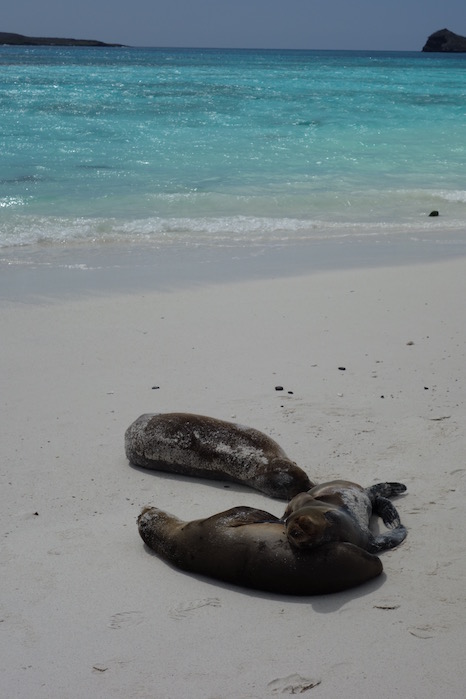
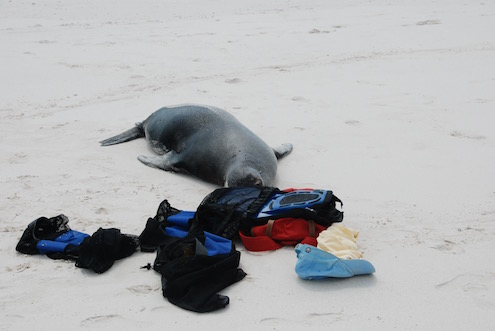
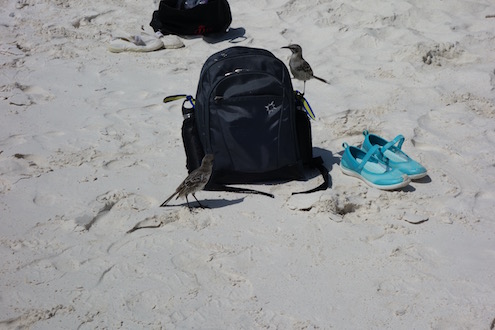
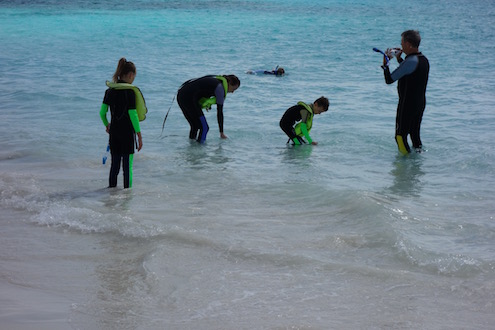
In order to limit the impact on this delicate environment, we were never ashore more than two hours, except in a town arena. We kept our stainless steel water bottles filled from the ship and there was no snacking! The Galapagos, a province of Ecuador since 1873 and in its possession since 1832, has been a National Park since 1959 and is, as such, a protected environment. I think the very fact that you’re there means you are invested in keeping it so.
After lunch, the kids met for an orientation of the Junior Naturalist challenge and there was a presentation about the geology and oceanography of the Galapagos volcanic formation. The “younger” islands in the west are still volcanically active. The archipelago is on the Nazca Tectonic Plate and each year creeps a bit closer to South America.
We set ashore at Punta Suarez for a long hike over uneven boulders and broken lava, coming upon a colony of waved albatross both hatching chicks and becoming reacquainted after time at sea. We climbed to a cliff where we watched frigate birds, found a snake and caught sight of the Galapagos hawk, one of two Galapagos avian predators. Along the way, we were greeted by marine iguanas we had to step over!



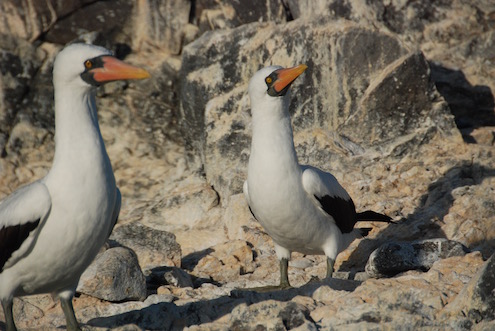
The 4th of July found us at Floreana Island and the option of a pre-breakfast walk and a wet landing directly from the Zodiac to the beach, getting our feet soaked in the process. This is why we were told to bring water sandals! The beach was greenish and scattered with bits of peridot. Our naturalist guide (didn’t have a favorite—they were all so informative and fun) took us on the fast track across to the other shore, hoping to catch a glimpse of a green sea turtle building a nest. One had been there because we saw her early morning track back into open water.
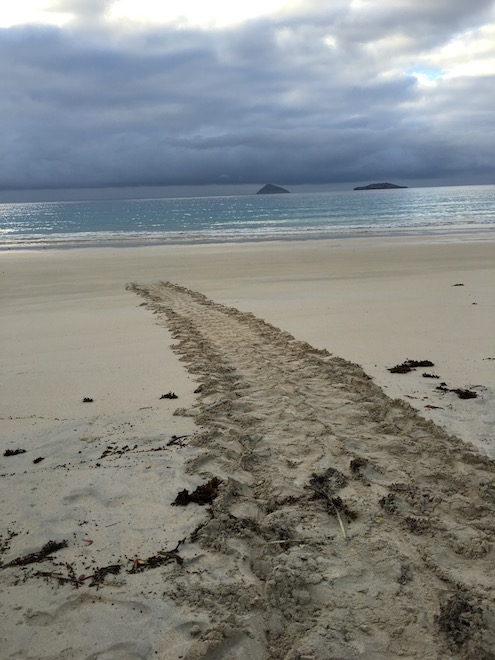
While we had briefly caught sight of a blue-footed booby the day before, once back on our original beach, we finally had our chance to see several up close.
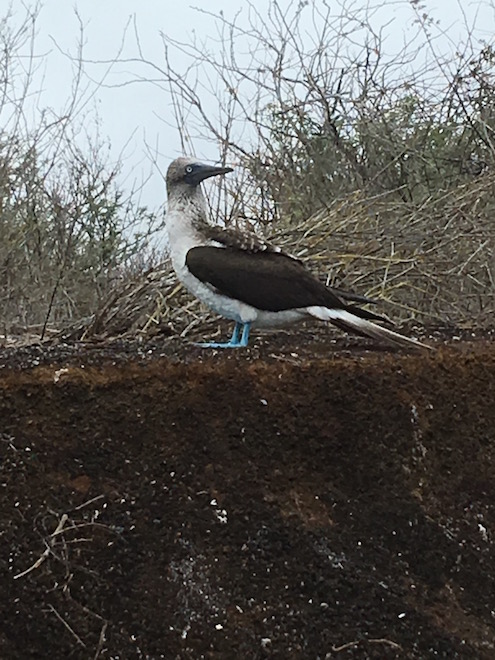
After lunch, we were treated to a presentation by Greg Marshall of Crittercam fame. We learned how he formulated the idea for attaching cameras to sea creatures (and his cat!) and saw the iterations of the device since 1986.
The afternoon found us at Post Office Bay. We had been told to bring our unstamped postcards with us for this wet landing. Unstamped? In a tradition going back two centuries, a barrel was—and is—used to deposit mail home. Whalers and visiting sailors started the tradition of leaving letters and then retrieving those they might deliver to the addressee. Our guides read out the city addresses of several hundred postcards left by visitors like us. Quite a few were picked up by our group to be hand-delivered, including one by our daughter-in-law, who delivered it in London much to the delight of the sender/recipient. So, if a stranger shows up at your door one day with a postcard from the Galapagos, you can’t say you weren’t warned.
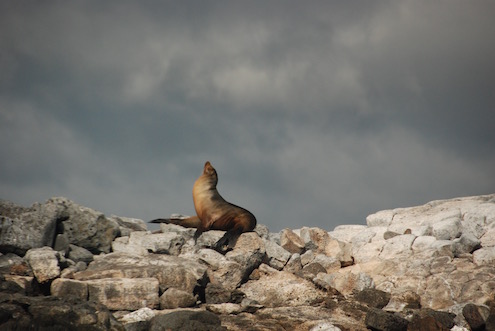
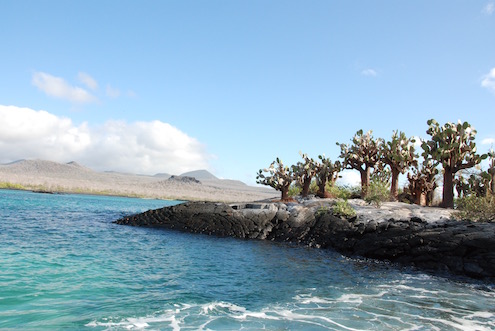
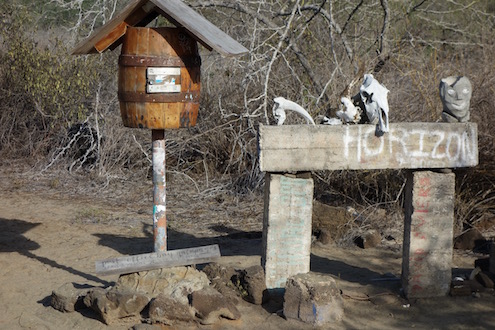
The ship’s crew treated us to a Fourth of July picnic dinner on the pool deck. No fireworks, just lots of laughter.
After breakfast on the 5th, we were once again anchored at a town, Puerto Ayora on the island of Santa Cruz. This is home to the Charles Darwin Research Station.
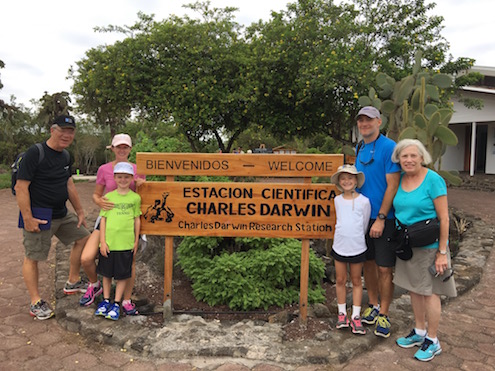
There’s a recently opened visitor’s center and a giant tortoise captive breeding center, starring Diego the giant tortoise, so named because he was found in San Diego. In the early 20th century, Diego and others had been shipped from the island of Espanola to San Diego. Once discovered that there were but a few Espanola tortoises still alive (imported rats having taken a liking to the eggs), the wild ones were rounded up. However, breeding help was needed and Diego was brought in. It is estimated that he is the sire of 40-45% of the Espanola tortoises now back on Espanola.
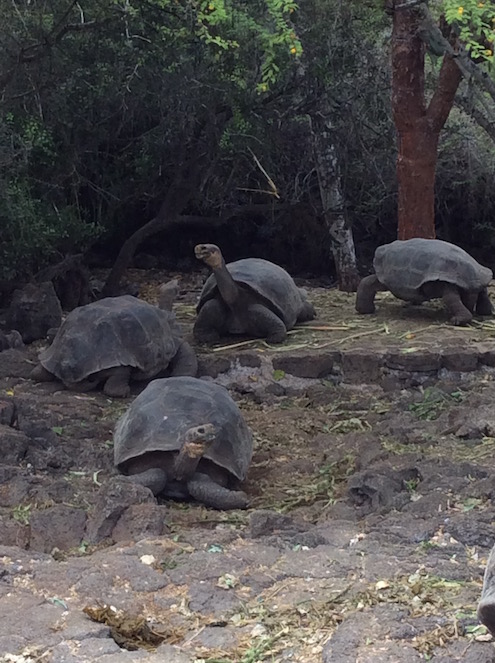
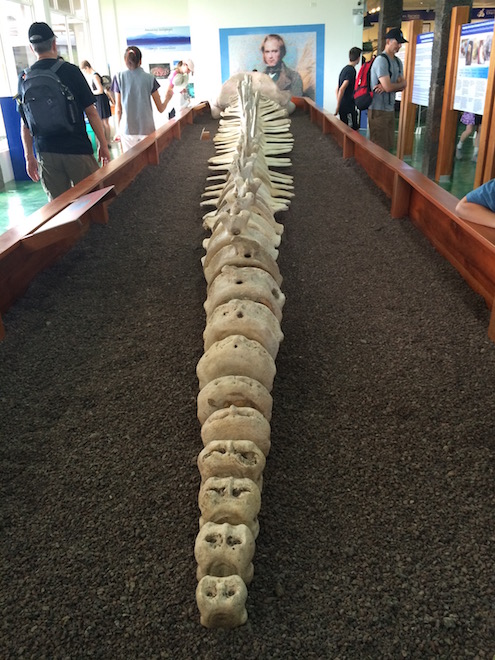
We strolled into town, shopping along the way. (Need a vacation with few opportunities to shop? May I suggest the Galapagos.) I think we had the most fun watching a sea lion and pelicans begging for fish at the local market. And I think the cat can get underfoot!
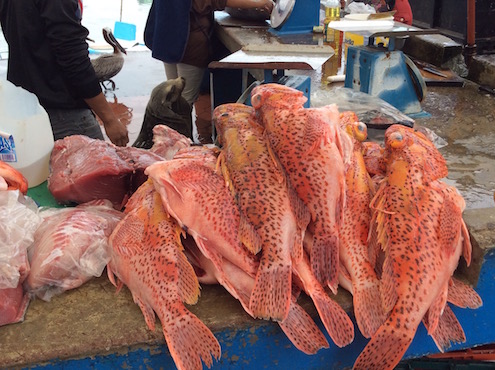
From here, half of us had opted to visit a local school, while the rest of us bussed to a sugar and coffee plantation, learning about traditional methods of farming before tourism became the predominant industry and tasting the final products: sugars, coffee and some 150 proof.

Good thing we had a bus to take us to the restaurant and the afternoon’s adventures among the free-ranging tortoises.
Note on the history of Lindblad Expeditions and National Geographic from the expeditions.com website:
Embodying “respectful tourism,” Lindblad Expeditions and National Geographic joined forces in 2004, “Inspiring people to explore and care about the planet.”
“The mission of the Lindblad Expeditions National Geographic alliance, simply stated above, is the natural extension of our respective passions to show people and teach them about the wonders of our fragile world.”
www.expeditions.com
www.darwinfoundation.org
www.Galapagos.org